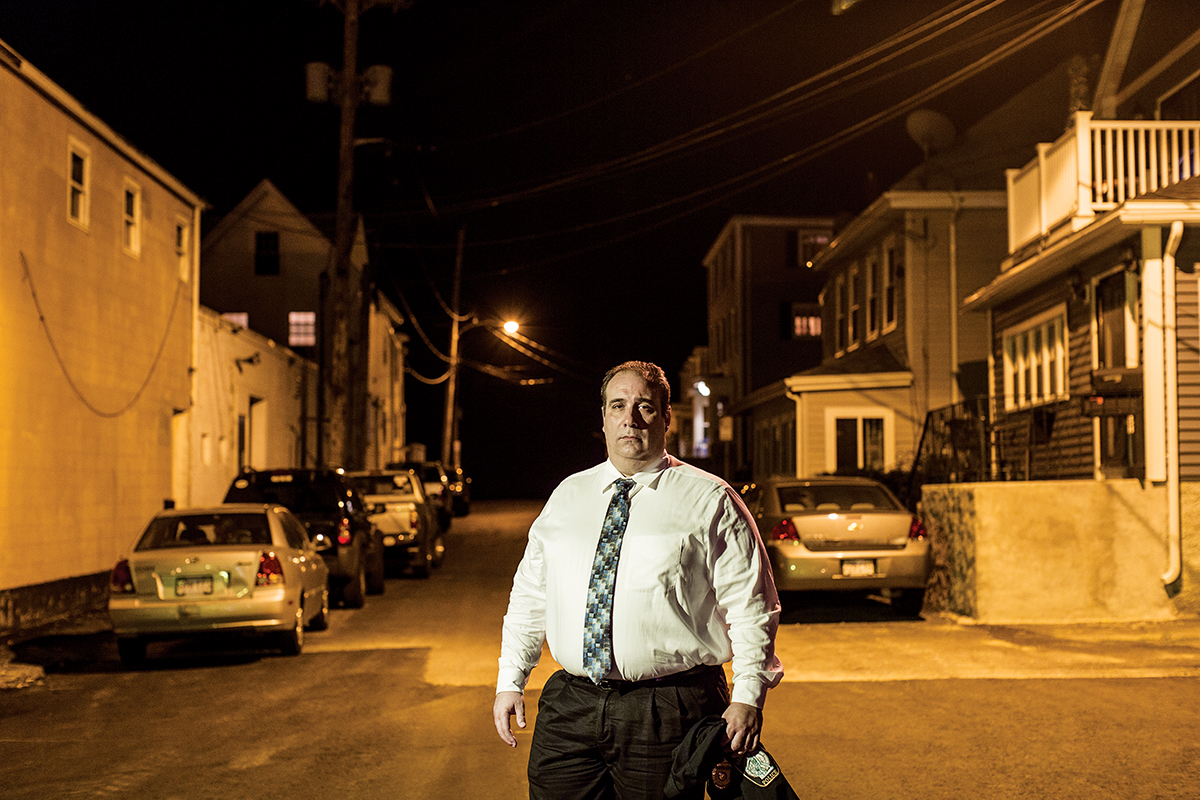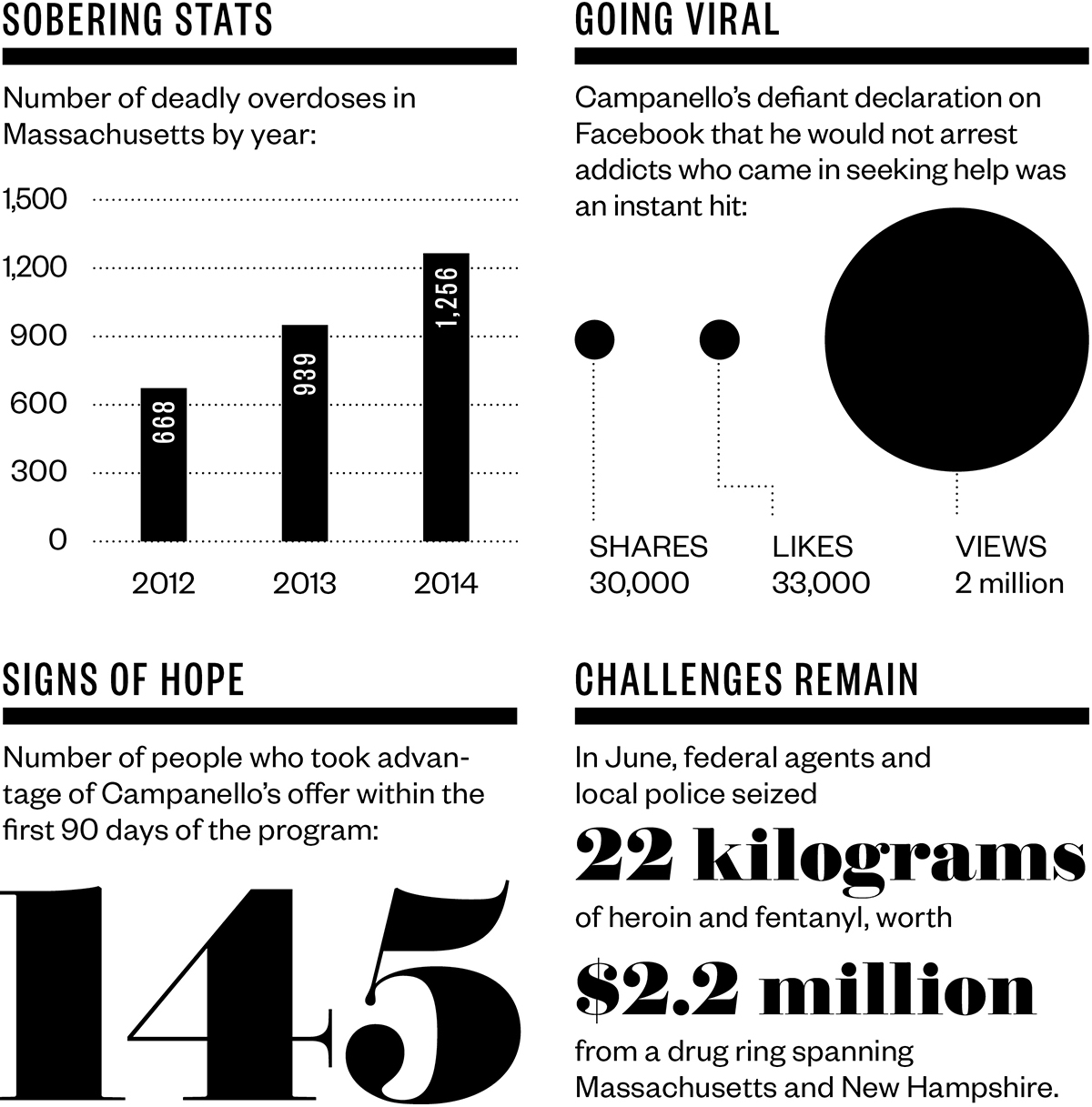Police Chief Leonard Campanello’s New Fight Against the Heroin Crisis

Photograph by Jesse Burke
Winter was wearing on Leonard Campanello.
A historic streak of blizzards and stinging single-digit temperatures had pounded Gloucester, the seaside city of 30,000 that he watches over as chief of police. Punishing winds roared through the hallowed fishing ports, carrying thick blankets of snow that clogged quiet side streets. Life ground to a halt, but the calls kept coming: overdoses—dozens of them. In most cases, first responders made it in time. Sometimes they didn’t.
Around midnight on the first Friday of March, Campanello got word of a grisly scene: a 44-year-old woman with brown eyes and gray hair, unconscious on a bathroom floor, her head dangling in the toilet bowl. Vomit hung in the water. The woman’s roommate, who found her when he returned home from work, peeled her from the porcelain, laid her body on the ground, and then called 911 before beginning CPR.
By the time paramedics arrived, the woman’s jaw was too stiff to accommodate a breathing tube. They loaded her into an ambulance and whisked her through the frozen night to Gloucester’s Addison Gilbert Hospital, where the woman’s father and sister arrived to learn that their beloved was dead. She was Gloucester’s fourth fatal overdose of the year. Campanello, his dark eyes sagging with fatigue, seethed. Barely two full months into 2015, and the number of fatal opioid overdoses in his city had already surpassed last year’s toll. This wasn’t a statistical fluke or a bad batch of heroin hitting town—this was the new norm.
For years, first as a detective in Saugus and more recently as the chief in Gloucester, Campanello had watched helplessly as the number of deadly overdoses in Massachusetts soared: 668 in 2012; 939 in 2013; 1,256 in 2014. Each death put the limitations of traditional policing into sharp relief for the 47-year-old veteran officer. In the late ’90s, when Campanello was lead detective of Saugus’s first narcotics unit, Purdue Pharma had aggressively marketed OxyContin as a safe, less-addictive pain pill. As the drug insinuated itself into affluent suburbs and sleepy farm towns, small police forces throughout the country found themselves under pressure to choke off the supply of pills. The war on drugs had undergone an abrupt about-face: Once, interdiction efforts had focused on keeping illegal drugs out of the country; now, the drug responsible for a wave of addiction was being manufactured legally and prescribed by doctors, often at so-called pill mills masquerading as pain-management clinics. Soon enough, a thriving black market emerged. Street prices for Oxy spiked; when people couldn’t afford Oxy anymore, they turned to cheap heroin. Dealers began cutting the heroin with fentanyl, a synthetic opiate that makes morphine look like baby aspirin. Overdose victims flooded into ERs. It was a goddamn mess. And it was getting worse—worse than anything Campanello had ever seen.
In Saugus, Campanello had first tried fighting the drug war the old-fashioned way. He and his two-man team knew that the miles of strip-mall parking lots lining Route 1 were popular with dealers and buyers hoping to blend into a sea of brake lights. They targeted those parking lots and made more than 100 busts in the first year, but putting pushers and addicts in jail didn’t make a dent. Supply and demand kept growing like deadly weeds. Frustrations that long simmered within Campanello boiled as the opioid epidemic tore through every corner of the state. Then, in 2012, he left Saugus to take over as chief of police in Gloucester.
But even when he was calling the shots, he couldn’t fix the problem any more in Gloucester than he could in Saugus. A statewide public health emergency was declared in 2014, and then in February, Governor Baker assembled a brand-new opioid taskforce to devise a solution. Communities throughout Massachusetts embraced Narcan, the lifesaving drug that reverses overdoses. But the bodies kept piling up.
Campanello had reached a breaking point. Possessed with an urgency to do something, he brooded over his options after Gloucester logged that fourth fatal overdose of 2015. The people he saw dying on his watch weren’t criminals; they were sick. Arresting them made no difference. What they needed was help—and from what he could tell, the insurance companies were a racket.

Campanello, heavyset with jowls and thinning hair, knew his limitations: just a small-town cop with a tiny budget and no power to enact laws. So on the morning of May 4, he logged into the biggest platform he had—the Gloucester Police Department’s Facebook account—and, for the first time, began typing out his defiant approach. Starting June 1, he wrote, “Any addict who walks into the police station with the remainder of their drug equipment (needles, etc) or drugs and asks for help will NOT be charged.” Instead, he and his officers would help them get medical care. It didn’t matter what insurance you had, or whether you had insurance at all—Campanello promised to shred the red tape that entangled so many who sought treatment. “I’ve never arrested a tobacco addict, nor have I ever seen one turned down for help when they develop lung cancer, whether or not they have insurance,” he concluded in the post. “The reasons for the difference in care between a tobacco addict and an opiate addict is stigma and money. Petty reasons to lose a life.”
He read the message over for typos, floated the cursor over the “Post” button, and clicked his mouse at 10:55 a.m. It instantly went viral, shared by more than 30,000 people, “liked” by 33,000, and viewed more than 2 million times.
The message he posted that day was less a decree than a rant, but it set in motion a policy that just may become the tipping point in Massachusetts’ fight against heroin, redefining how police wield power in the war on drugs. Over the next few weeks, notes of support, thank-you letters, and calls from reporters around the world flooded Campanello’s office. The outpouring emboldened the burly police chief, and as June 1 drew closer, he began to toughen his rhetoric. The drug war, he declared, had been a failure. Rather than go after addicts, it was time to go after corporations. He made veiled threats to pharmaceutical firms—the “Exxon Valdez” of the opioid crisis, which “all but admitted that their drugs lead to addiction”—and slammed insurance companies for their “apathy and whininess.”
Then, on May 31—the day before Campanello began granting amnesty to addicts—tragedy struck. Another deadly overdose stunned Gloucester. This time, the victim was a 56-year-old man whose last-known address had been a shelter located just a few doors down from the police station.
The next morning, Campanello sat in his office, watched over by a bumper sticker on the wall that read “Strong Men Don’t Bully” and a statue of the Archangel Michael, who, according to Scripture, slayed the devil. As the chief grieved the latest loss, he couldn’t help but silently wonder whether anyone in the throes of addiction would actually come to the police for help.
Fueled by cheap heroin and a steady supply of new users, Massachusetts’ opioid epidemic has consistently overwhelmed the outdated government, nonprofit, and medical infrastructure built to fight addiction. Between 1998 and 2008, the number of people treated for addiction to opioids in the United States increased by a staggering 400 percent. Federal and state authorities responded by cracking down on prescribers in hot spots such as Arkansas and Florida. Their efforts failed to stem the cross-country flow of pills, but succeeded in making prescription opioids more expensive on the black market—pills that once cost $5 or $10 were now $25 or $30. That, in turn, created a seller’s market for heroin dealers, who could provide more-potent highs at a fraction of the cost. Not only had prescription opioids been highly addictive, the new drugs had annihilated old stigmas. For tens of thousands of people shooting heroin today, the road to their first hit was paved with legally prescribed pain meds.
And Massachusetts’ heroin addicts are cursed with one of the most active drug markets in the country. The Department of Justice has long considered the Bay State a key “staging area” for street-drug wholesalers to push product from New York into New England, resulting in a surplus of cheap heroin from Holyoke to the Back Bay. For $10, you can score a bag of brown powder that’s potent enough to keep you high for days, and possibly kill you. While it’s hard to quantify how much illicit dope is in the state, consider these recent busts: In March, police arrested three men in Everett with 14 kilos, worth an estimated million bucks. In June, federal agents and local police seized 22 kilograms of heroin and fentanyl, worth an estimated $2.2 million, from a drug ring that spanned Massachusetts and New Hampshire. And in July, during a routine traffic stop, police in Lawrence busted a man with 7 kilos.
Heroin’s chokehold on Massachusetts has progressed with a numbing, lethal efficiency, but the state’s response to it has been dwarfed by the sheer scale of the epidemic. During the first half of 2014, as the number of overdoses continued to climb, the awful reality began to dawn on local and state leaders, and there was a sharp shift in how they talked about the crisis. That March, then-Governor Deval Patrick declared a public health emergency and ordered that Narcan be available to all first responders. In April, Patrick and Mayor Marty Walsh teamed up for a prescription-drug take-back program, part of a nationwide effort that once removed a whopping 309 tons of excess prescription drugs from the streets. In June, Walsh called on the U.S. Conference of Mayors to convene a nationwide task force on addiction. A year later, incoming Republican Governor Charlie Baker formed an 18-person statewide task force on opioid addiction. Yet these were largely conventional responses to an increasingly unconventional enemy. And when it came to law enforcement—to the officers dealing with the crisis day in, day out—well, they were pretty much on their own.

